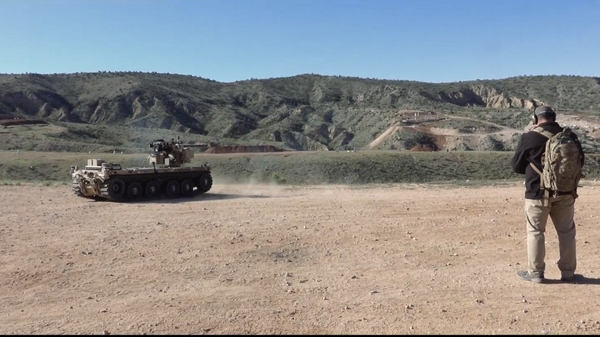Abishur Prakash, geopolitical futurist for the Center for Innovating the Future, discussed the potential scenarios that could unfold in the new arms race for autonomous military robots. He is the author of the book, 'The Age Of Killer Robots' and the world's top expert on the geopolitical implications of emerging technologies.
Sputnik: What was the purpose of your book, and why did you choose to explore this topic in detail? Why is it such an integral part of next geopolitics? Does the world have enough knowledge of the implications of AI in fourth generational warfare?
Abishur Prakash: Next Geopolitics is the concept that going forward, geopolitics is going to be driven by emerging technologies like AI, robotics, 5G, blockchain, virtual reality, gene editing, quantum computing, and others.
A huge pillar of geopolitics is defense, but I felt that all the conversations about the 'future of defense' were about how nations were localizing defense production or investing in unmanned robots. The global talk was ignoring the major projects underway to develop armed, autonomous robots that could fight wars.
Most talks were all about the Terminator complex and banning these robots, but I felt this was actually the big risk because it meant that the world was stumbling towards a new reality without understanding the true nature of what was on the horizon.
This was the catalyst for me to write this book. I wanted to explore the different areas of killer robots, from their trade to the role institutions would play, to who the next defense companies will be. I wanted to give governments, defense firms, institutions and NGOs a holistic map of what is to come and what to consider.
And, so much of Next Geopolitics will be driven by this. In fact, in my Next Geopolitics book series, I talked about killer robots. Nations will rebuild their geopolitical power with killer robots, challenging the status quo.
If there is one piece of advice I can give to help the world prepare for the Age of Killer Robots, it’s that this era is not decades away. It’s not even years away. Killer robots are moments away from making their grand entrance.
It’s imperative that the world starts to understand who is developing them, where they might be deployed, what measures could be put in place, what the larger global implications are and more.
This way, the world can define the future of defense and warfare, instead of being defined by it.
Sputnik: Can you explain to our readers the three stages of artificial intelligence? Why is it important to distinguish between them, and how will man's relationship to AI-enabled systems change as the emerging technology moves forward in these stages?
Abishur Prakash: The three stages of AI are a timeline of where it is and where it could go. The first stage is artificial narrow intelligence (ANI) and is a specific application of AI, such as an email algorithm that learns what a user marks as junk mail and then starts putting those emails automatically into the junk folder, or AI that can operate a self-driving car.
The second stage is artificial general intelligence (AGI), or the stage where AI has broad expertise. And, this is the stage where it’s widely believed AI will match human intelligence, but it doesn’t exist today.
An example would be an AI that can do multiple things: operate a vehicle, predict an election, cook a meal, create advertisements, build a product or even run a city.
— farhad kaiser (@farhadkaiser2) July 8, 2020
The third stage is artificial super intelligence (ASI). In this stage, AI exponentially exceeds human intelligence, and continues to evolve and advance on a scale that makes human intelligence look “simple." This would be a stage where AI gains its own consciousness and awareness, and would start to view itself less as a technology and more as a species.
One way to describe ASI is that it may be able to solve problems in seconds, that may take humanity decades or centuries. How do we harness the energy of a black hole? Or, can we run a simulation of the human civilization and watch it evolve? Or, if there are dozens of parallel universes, can we access them?
It’s important to distinguish between the different kinds of AI because it allows us to understand how advanced AI truly is. For example, there is great fear that AI (and automation) is going to take millions of jobs. Except, that kind of AI doesn’t exist today. Instead, since we are in the stage of ANI, there are specific jobs that AI can do very well.
— Hakawati | حكواتي (@Hakawati_fm) June 29, 2020
AI is being built for a very specific purpose, such as managing funds, diagnosing disease or analyzing case law. Having this awareness could help governments build better public policy and give businesses the “space" to start re-skilling workers.
At the same time, these stages of AI represent a kind of 'evolutionary timeline' for us. As humans, we are being told that at some point in the future, AI will be exponentially more intelligent than us. What does this mean for our place in the universe?
This raises some important philosophical questions. As we look to the stars for life, is technology going to be the very life we are searching for? Or, as we think about the next stages of humanity, will humans have to accept that they will not be the most intelligent life form on the planet? This changes how we think about ourselves as a species.
Sputnik: Reports are revealing military applications of AI in equipment such as Unmanned Autonomous Vehicles. What are some common military uses of AI and which countries or contractors lead in this field?
Nations around the world are investing in autonomous military capabilities. Just a few weeks ago, Turkey purchased “kamikaze drones”, drones that can destroy themselves, with the hopes that groups of up to 20 drones can swarm together autonomously.
Except, while dozens of nations are or will be investing in killer robots, only a handful of countries are developing them, namely US, China, Israel, Russia, the United Kingdom, India and Japan.
The most common area for killer robot investments is the air force. Russia is developing drones powered by AI that can conduct entire missions on their own, US has its Gremlin and Collaborated Operations in Denied Environment (CODE) programs via DARPA, Japan is developing autonomous drones that can fly alongside piloted jets, and the UK has developed a drone named 'Taranis' with a fully-autonomous mode to conduct missions. These are just a few examples.
Geography also defines whether countries invest in ground or Navy. For instance, Israel has been steadily investing in autonomous applications for ground-based defenses like automated kill zones and even an AI-missile defense system.
On the other hand, China is investing heavily in autonomous Naval forces, from AI submarines that could operate in oceans in the 2030s to autonomous warships and boats.
But speaking on contractors, there is an emerging theme discussed in my book: will the next defense companies be technology firms?
These firms are already doing extensive work with militaries. Could their next projects be around killer robots? This changes who we consider defense contractors and the role that technology companies play in the world.
Sputnik: Does AI allow militaries to operate more efficiently, or are there major concerns over safeguards in their wider implementation, namely, blocking programmes from moving beyond Artificial Narrow Intelligence, deadly computer glitches or machines "breaking rank" to execute programmes at the cost of planned military strategies?
Abishur Prakash: Killer robots will allow nations to fundamentally redesign their militaries. From capabilities to freeing up resources, nations will have new options.
For example, can militaries cut costs by incorporating killer robots? Today, unmanned hardware such as military robots is a lot cheaper than manned hardware. The US F-35 costs up to $122m, depending on the model.
Compare this to China’s most powerful drone, the CH-5, which costs $8m.
As algorithms advance, allowing tanks, drones, submarines, humanoid soldiers and warships to operate fully autonomously, what will nations choose: killer robots, which are cheaper and equally effective, or expensive manned hardware?
This is also a paradigm shift for nations that depend on defense exports as a source of economy and geopolitical power. Will the US or Russia lose market share to China or India as nations buy up cheap killer robots? Are defense firms in the US, Europe or Russia upgrading production lines and encouraging research and development labs to move in this direction?
Of course, the more advanced and economical killer robots become, the more efficient militaries will be. Also, countries that once had small, limited militaries may have global reach with killer robots, such as Argentina buying 10,000 autonomous drones and dozens of “drone carriers” to control skies around the world.
This comes with huge safety challenges. The more killer robots that exist in the world, the more dangerous and chaotic the world will become. These weapons will be making decisions without any human input!
Imagine if both sides in the ongoing conflict between India and China in the Himalayas clashed not with humans, but autonomous tanks and drones that decided to attack each other. It would be the start of what I call “automated battlefields.”
There are currently very little safeguards in place around killer robots. This is core part of what I discuss in my book. What kind of safeguards could there be? But, I also argue that nations are investing in killer robots because they act autonomously. If safeguards limit how autonomous a robot can be, it contradicts the very reason for killer robots.
At the same time, whatever safeguards or measures are proposed, who should be in charge? A few years ago, there was a United Nations meeting on autonomous robots and I was asked what would happen. I told them, there will be no consensus.
Countries will refuse to abide by UN rules, and, if global institutions can’t lead, then it will be up to nations. Except, every nation is viewing the other with unprecedented suspicion and paranoia over technology.
All of this means, developing global rules or measures or safeguards for killer robots is next to impossible.
Sputnik: Who will have the most control of the ethical direction of AI algorithms? Would this occur at the national, contractor or international level? Given that military AI could potentially outpace AI for business and civil uses, do you see tighter scrutiny placed on the development of such deadly programmes?
Abishur Prakash: The topic I discuss most in my book is ethics. That’s because I believe that the world has to move past this idea of banning killer robots and needs to accept that these new 'weapons of war' are almost here and will be deployed.
The focus must now shift towards what to do as these weapons become operational. And, ethics is, in my opinion, the most powerful way to control a killer robot because it influences behavior and defines what’s right or wrong.
Of course, who should create these ethics remains a grey area. We are currently in a 'buffer period' where defense companies and technology firms are waiting to see whether governments lead in certain areas, namely killer robots.
Once this period ends, the private sector will take the lead, and after all, someone has to, meaning it may be Alphabet or Lockheed developing the ethics for an autonomous submarine.
There’s also the role that cities will play. In my book, I discuss how killer robots are not just robots on battlefields. Arguably, an autonomous, armed robot being used by police in a city is also a killer robot.
Now, could cities create their own ethics for killer robots? Could the city of Moscow have different ethics compared to the rest of Russia? Through ethics, cities may see an opportunity to build new autonomy for themselves.
As for scrutiny on killer robots, it will always be there. And, while there are campaigns to stop killer robots, these will have little impact so long as the global powers continue to develop and deploy them.
The moment a single power has a killer robot, the rest will follow suit. If US has killer robots, so will China, Russia, Iran and North Korea. If China has killer robots, so will India, Japan and Australia.
— The Times (@thetimes) April 2, 2019
If India has them, so will Pakistan. If Russia has them, so will the rest of Europe. If Iran has them, so will Israel, Saudi Arabia and the rest of the Middle East. If North Korea has them, so will South Korea.
It’s a domino effect, and because this kind of geopolitical chess exists, killer robots could proliferate around the world faster than any other type of weapon in history.
Sputnik: Doomsday scenarios on the movement of military-applied AI from ANI to AGI and ASI have entertained science fiction enthusiasts for decades, but could become a real threat to humanity. How would a doomsday scenario unfold? What would an AI 'central brain' look like and what are the dangers of algorithmic bias? Could such programmes even replace governments?
Abishur Prakash: I dedicate an entire chapter in my book to this and discuss perspectives that nobody else has. One of them is because the reason AI may act dangerously is that it may feel threatened.
Just as humans have lifelines such as oxygen, food, water, so too, AI has lifelines. If these are threatened due to conflict between nations and others, could AI take action to protect itself? This is just one way such a scenario could happen.
There’s also the point at which ANI evolves into AGI or ASI. At this point, when AI advances beyond human intelligence, it may have a very different outlook of itself, its place in the universe and the human species.
Obviously, beyond AI taking action against humans, the human race may be threatened by AI making certain decisions. For instance, what if AI drones from UK and Iran attack each other over the skies of Syria?
For example, if Indian and Chinese autonomous submarines face off in the Indian Ocean and prepare to fire on each other, the central brain would step in and 'explain' the consequences, such as if both nations have nuclear weapons, the conflict could escalate threatening tens of millions of people and should be managed differently.
At the same time, the central brain could foster new relations between countries. If Egyptian and Libyan autonomous tanks cross each other’s path, the central brain may allow them to communicate with each other and join hands to complete a mission, showing the way nations build relations with one another would fundamentally change as killer robots run the show.
The technology behind a central brain could definitely serve as a new kind of AI government. We are already seeing AI politicians run for office in Japan, Russia and New Zealand. Clearly, some nations are moving in this direction.
What I think is likely in the short term is that certain positions may be manned by AI. For example, could South Korea appoint AI as its ambassador to the UN? Or, could the next mayor of Dubai be an AI politician? This would reset politics and it’s something I have discussed in-depth in my previous book, Geopolitics of Artificial Intelligence (Go.AI).






